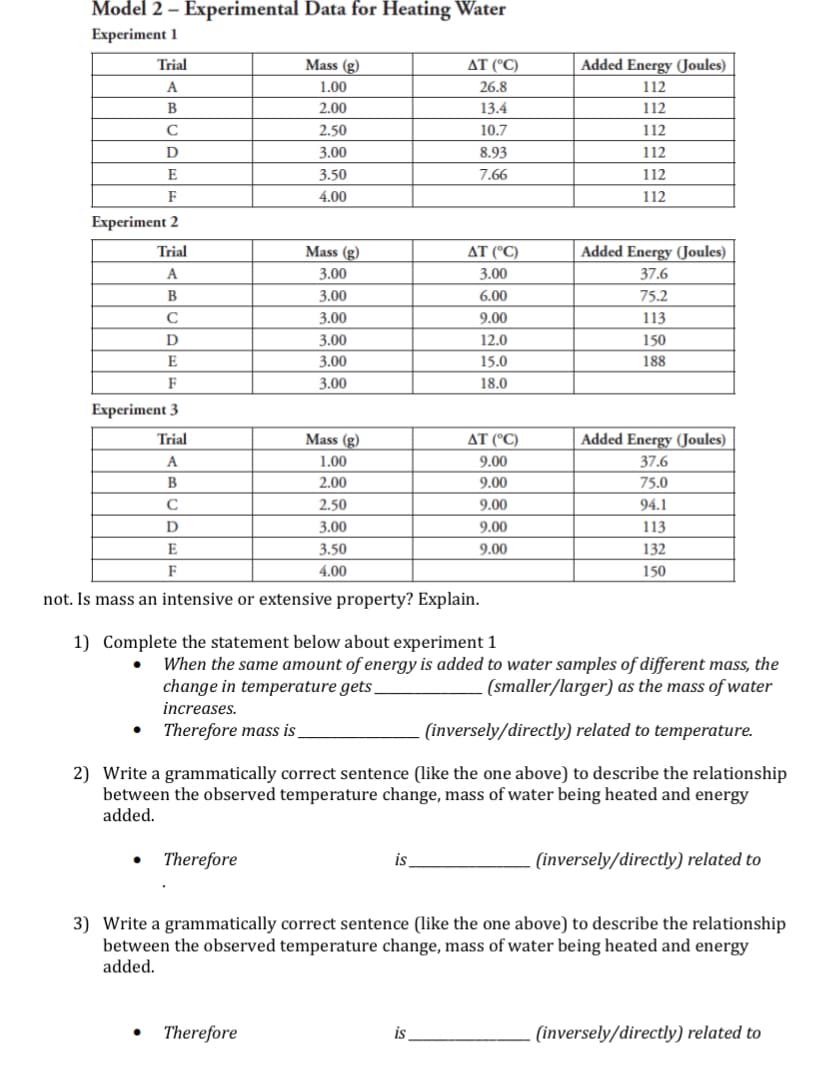Model 2 – Experimental Data for Heating Water Experiment 1 Trial Mass (g) AT (°C) Added Energy (Joules) 1.00 26.8 112 B 2.00 13.4 112 2.50 10.7 112 D 3.00 8.93 112 E 3.50 7.66 112 F 4.00 112 Experiment 2 Trial Mass (g) ΔΤ (C) Added Energy (Joules) A 3.00 3.00 37.6 3.00 6.00 75.2 3.00 9.00 113 3.00 12.0 150 E 3.00 15.0 188 F 3.00 18.0 Experiment 3 Trial Mass (g) AT (°C) Added Energy (Joules) 1.00 9.00 37.6 B 2.00 9.00 75.0 C 2.50 9.00 94.1 D 3.00 9.00 113 3.50 9.00 132 F 4.00 150 not. Is mass an intensive or extensive property? Explain. 1) Complete the statement below about experiment 1 When the same amount of energy is added to water samples of different mass, the change in temperature gets (smaller/larger) as the mass of water increases. Therefore mass is (inversely/directly) related to temperature. 2) Write a grammatically correct sentence (like the one above) to describe the relationship between the observed temperature change, mass of water being heated and energy added. Therefore is (inversely/directly) related to 3) Write a grammatically correct sentence (like the one above) to describe the relationship between the observed temperature change, mass of water being heated and energy added.
Model 2 – Experimental Data for Heating Water Experiment 1 Trial Mass (g) AT (°C) Added Energy (Joules) 1.00 26.8 112 B 2.00 13.4 112 2.50 10.7 112 D 3.00 8.93 112 E 3.50 7.66 112 F 4.00 112 Experiment 2 Trial Mass (g) ΔΤ (C) Added Energy (Joules) A 3.00 3.00 37.6 3.00 6.00 75.2 3.00 9.00 113 3.00 12.0 150 E 3.00 15.0 188 F 3.00 18.0 Experiment 3 Trial Mass (g) AT (°C) Added Energy (Joules) 1.00 9.00 37.6 B 2.00 9.00 75.0 C 2.50 9.00 94.1 D 3.00 9.00 113 3.50 9.00 132 F 4.00 150 not. Is mass an intensive or extensive property? Explain. 1) Complete the statement below about experiment 1 When the same amount of energy is added to water samples of different mass, the change in temperature gets (smaller/larger) as the mass of water increases. Therefore mass is (inversely/directly) related to temperature. 2) Write a grammatically correct sentence (like the one above) to describe the relationship between the observed temperature change, mass of water being heated and energy added. Therefore is (inversely/directly) related to 3) Write a grammatically correct sentence (like the one above) to describe the relationship between the observed temperature change, mass of water being heated and energy added.
Organic Chemistry: A Guided Inquiry
2nd Edition
ISBN:9780618974122
Author:Andrei Straumanis
Publisher:Andrei Straumanis
Chapter13: Substitution
Section: Chapter Questions
Problem 9CTQ
Related questions
Question
Please help me complete question 1,2,and 3

Transcribed Image Text:Model 2 – Experimental Data for Heating Water
Experiment 1
Trial
Mass (g)
AT (°C)
Added Energy (Joules)
A
1.00
26.8
112
B
2.00
13.4
112
C
2.50
10.7
112
3.00
8.93
112
3.50
7.66
112
F
4.00
112
Experiment 2
Trial
Mass (g)
AT (°C)
Added Energy (Joules)
A
3.00
3.00
37.6
B
3.00
6.00
75.2
3.00
9.00
113
D
3.00
12.0
150
3.00
15.0
188
F
3.00
18.0
Experiment 3
Mass (g)
Added Energy (Joules)
37.6
Trial
AT (°C)
A
1.00
9.00
B
2.00
9.00
75.0
2.50
9.00
94.1
3.00
9.00
113
E
3.50
9.00
132
F
4.00
150
not. Is mass an intensive or extensive property? Explain.
1) Complete the statement below about experiment 1
When the same amount of energy is added to water samples of different mass, the
change in temperature gets
(smaller/larger) as the mass ofwater
increases.
Therefore mass is
(inversely/directly) related to temperature.
2) Write a grammatically correct sentence (like the one above) to describe the relationship
between the observed temperature change, mass of water being heated and energy
added.
Therefore
is
(inversely/directly) related to
3) Write a grammatically correct sentence (like the one above) to describe the relationship
between the observed temperature change, mass of water being heated and energy
added.
Therefore
(inversely/directly) related to
Expert Solution
This question has been solved!
Explore an expertly crafted, step-by-step solution for a thorough understanding of key concepts.
This is a popular solution!
Trending now
This is a popular solution!
Step by step
Solved in 2 steps with 2 images

Knowledge Booster
Learn more about
Need a deep-dive on the concept behind this application? Look no further. Learn more about this topic, chemistry and related others by exploring similar questions and additional content below.Recommended textbooks for you

Organic Chemistry: A Guided Inquiry
Chemistry
ISBN:
9780618974122
Author:
Andrei Straumanis
Publisher:
Cengage Learning

Organic Chemistry: A Guided Inquiry
Chemistry
ISBN:
9780618974122
Author:
Andrei Straumanis
Publisher:
Cengage Learning